Creating a food forest in North Florida is something I’m good at (I literally wrote the book on it), so I like questions like the one that arrived in my inbox early this week.
Hanna writes:
“Hello David,
I’ve read 3 of your books. They’re awesome, thanks!
My hubby and I just bought an acre + by a lake in (North Florida).
The property is pretty wild. Many (most) trees need to come down, as they are a hazard. (One already fell on the house…)
We want to transform the yard into an edible forest! J
(Along with a square foot gardening section as well.)
I wanted to reach out to you before we start for a few reasons.
We’ve had horrible experiences with termites, so the idea of leaving logs to rot on the property is super scary.
To this end we’re trying to figure out how far from the home such a pile should be and how many trees do we actually need to leave to slowly convert the whole property from sand to soil?
Also, is there anything in the lake that would be good for composting? I didn’t find anything in your composting book about it.
Third and final question, is there anyone in our area who would be suited for cutting down and removing/leaving/chipping the correct amounts for a food forest that you could recommend?
The aerial map shows our bushy property in the middle of a bunch of manicured properties. We don’t want to see our neighbors, so privacy towards the sides is on the wish list with regard to what to plant there in the future.
Looking at the picture, top right is where we thought we’d put our square foot veggie garden. The sun starts its journey on that side in the morning.
Any tips/help is appreciated to help tackle this project!!!
Thanks Again,
Hanna”
Here’s a shot off the back porch:
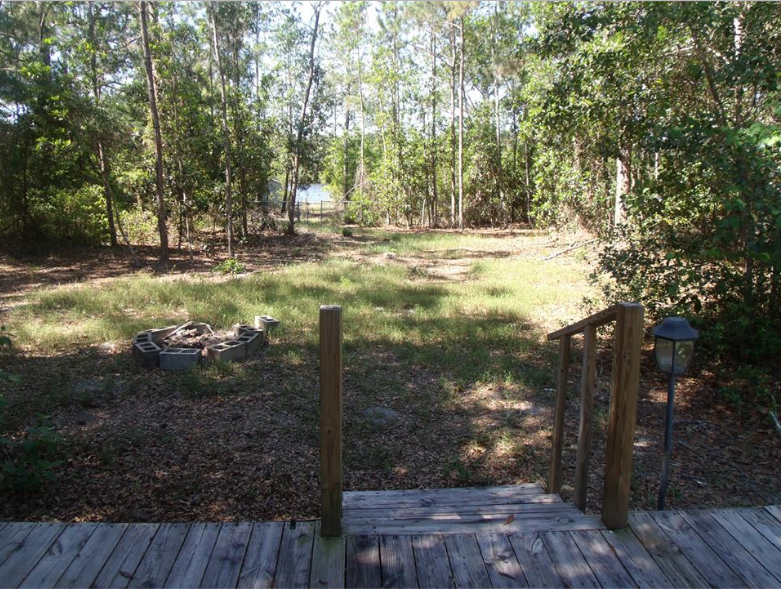
And an aerial view:
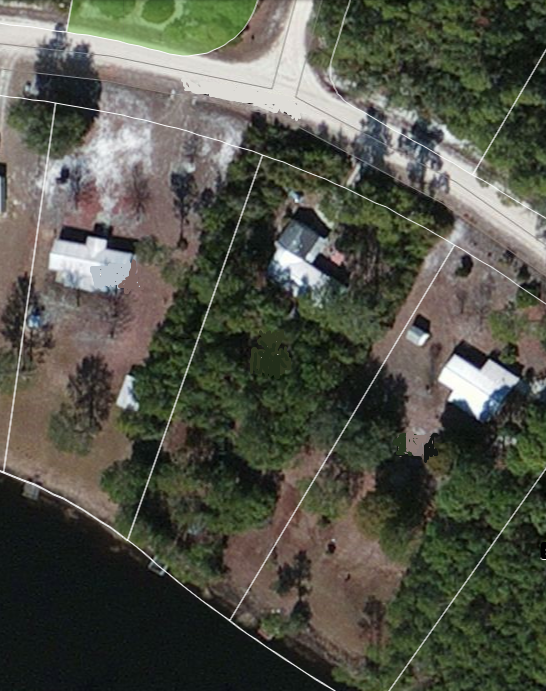
And one of those dangerous randomly falling Florida oaks:
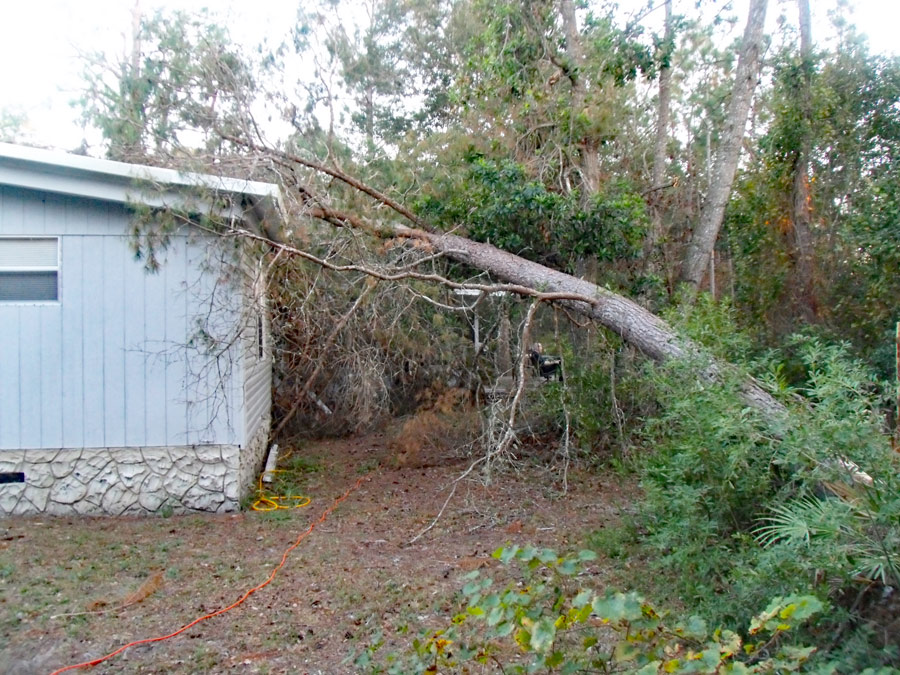
Let’s jump in.
Rotting Wood and Termites
Hanna is rightly concerned by termites:
“We’ve had horrible experiences with termites, so the idea of leaving logs to rot on the property is super scary.
To this end we’re trying to figure out how far from the home such a pile should be and how many trees do we actually need to leave to slowly convert the whole property from sand to soil?”
Termites are everywhere in Florida, including in mulch. They will even eat sweet potatoes and sugarcane on occasion.
I paid to have my house treated, as I figure it’s pretty much impossible to keep them out, logs or no logs. They were chewing their way through the walls of my bathroom at one point. If you were quiet, you could hear the creak of their gnawing. We hired a pro and the problem was eliminated. As much as I hate poisons, there are times they are necessary.
If you don’t want termites and don’t want to spray, you basically need to have a desert around your house. Even then… you’re not guaranteed safety.
I let the termites eat logs in my yard but most all of the logs were 20 or more feet from the house itself. Termites are great at making soil, so I let them make soil. In your yard they’re an asset to your food forest project.
It’s hard to say how many trees you would need. I’m guessing Hanna means trees that would be mulched or buried to make soil. The more, the better. I would leave quite a few trees standing, though, as their leaves keep falling year after year and building the ground.
Lake Compost
“Also, is there anything in the lake that would be good for composting? I didn’t find anything in your composting book about it.”
Yes, lakes can be good sources for biomass. Water hyacinth makes great compost but many Florida waterways are sprayed with weedkillers to eliminate that resource.
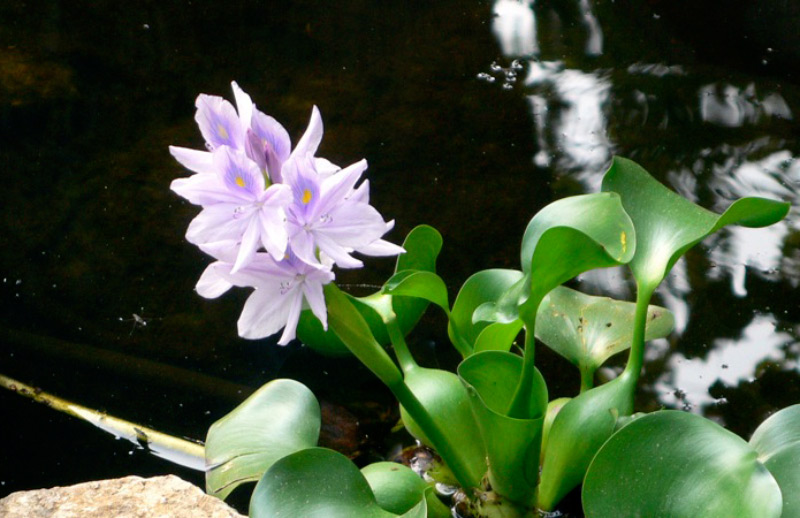
Water hyacinth
Muck from the lake is a good addition to garden beds and compost heaps.
All the weeds along the shoreline can be cut and used as mulch. Cattails and other reeds are good for this.
Wood Chip Resources
“is there anyone in our area who would be suited for cutting down and removing/leaving chipping the correct amounts for a food forest that you could recommend?”
I don’t have a recommendation, unfortunately, but I would call around locally and tell tree guys what you want.
My wood chips for the food forest came from the guys that were clearing the power lines in the neighborhood. I asked them to dump mulch and they did, leaving literal tons of it. We spread it a foot thick and a year later I had great soil.
If you have more than enough, leave a bunch of it in a pile. You’ll want it later – I guarantee it. After two years it makes good potting soil and garden bed compost.
My North Florida Food Forest Suggestions
First, leave as many trees as possible.
When the trees are removed in Florida, you end up with higher heat during the summer and colder lows during the winter. I describe this effect in my book Push the Zone. Trees moderate the climate around your home, and North Florida has huge swings in temperature that really mess up gardens.
Cutting the dangerous oaks around the house makes sense, but don’t clear too exuberantly. I did, and I regretted it.
Second, search for useful species carefully before removing anything
Your area has wild grapes (I can see some in the image with the fallen tree) which are quite nice to eat. You may also have persimmon, black cherry, pawpaw species, blueberries, sparkleberries and multiple other good forage species. Chances are you also have colonies of good edible mushrooms such as boletes and chanterelles, which only live around specific trees and fruit at specific times of the years. If you chop too fast you can lose a lot. It may all look like scrub and brush, but if your eyes are good you’ll see more than you think. I have picked excellent wild blueberries at the edge of a gardener’s yard – he had no idea they were there and was thrilled to find them.
Third, try double-digging beds instead of square foot beds
Just double-digging the ground and adding some compost has worked better for me than building beds. Raised beds in Florida need more water than in-ground beds. Plus, you don’t have to build anything to get planting when you go for double-digging.
Fourth, plant things on purpose to feed the soil
Get some Tithonia diversifolia and start popping it into the ground. When you put down mulch, plant black-eyed peas in it. Stick nitrogen-fixing trees all over the place. Having material to chop-and-drop will be a big help. Florida sand is always greedy for organic matter.
Finally
If anyone is reading this and has questions about establishing a Florida food forest, get in touch. I am available for consulting via Skype at a reasonable rate and it will be worth it. A food forest is a long-term investment of time and money. Getting it started right can save you.
Good luck, Hanna – you have a beautiful piece of property and I think you’ll have a wonderful time.
* Water hyacinth image credit


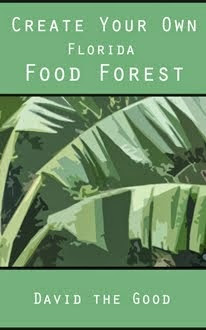
8 comments
David, have you tried using Diatomaceous Earth and/or beneficial nematodes to help control unwanted bugs? I have been using both near my house to reduce fleas and other pests and so far it is working well. The dogs have been free of fleas for months. My reading states that these items are good for reducing the termite population as well. YMMV of course.
Please don’t try and remove all that gorgeous existing foliage. Concentrate on removing the dying trees instead. Because as David says, you will become a heat and cold sink. You will become a wind farm too, as there will be nothing to protect you. Use your existing foliage as a transition for your new food forest, instead.
On our property, we had to deal with native scrub. So we had a rule to remove large, native trees, within 30 metres of our house. Because that’s how tall some of the native trees could grow. We had little seedlings coming up all the time though, which we used as nursery trees, for the edible trees we were establishing. So long as they didn’t get beyond 10-12 metres high, they could stay. Higher, and they were removed, and used as mulch, or building small retaining walls on our slope.
I have a brick house, with a 1.8 metre verandah, so we can see if any termites attempt to gain access to the house. But we haven’t really had a problem with them, coming to our mulched gardens near the house. Since they prefer to build nests where the greatest wood supply is. So if you keep patches of your native areas (where it’s safe to do so) you’ll find the termites hang out there. Why would they want to come visit your thinly spread mulch, when they’ve got enormous trees to disembowel?
Another trick I like to use in relation to controlling termites, is not to disturb ant colonies on your property. Ants are termites, natural predators. I only poisoned ant nests, when they were meat ants, that bit, and their nests were built near our cars, or walkways. But we left the smaller ant colonies, around the house alone. The reason most people have problems with termites in their house, is because they don’t want ant nests near their house either. We only poison the dangerous big one’s around the house, but let the little guys, defend us against termites.
The big meat ants, have nests elsewhere on the property, and we leave them alone. It’s only when they become a stinging issue, around the house, we move them on. So befriend your ant colonies, and they’ll work to keep your termite colonies under control. You won’t see termites move into areas, with regularly used ant highways. The ants come to the house, to clean up the dead insects attracted to your inside lights at night. Or they’ll come to your rubbish bins for food. Don’t fear the ants. They are your friends in termite country.
Which is another reason to keep your native foliage, until you can transition some areas to an edible food forest. It attracts insects which ants predicate on. They are an important species to maintain ecological balance.
Hi Chris,
Thanks for your lengthy reply!
Here is an excerpt from the thank you letter I sent to David:
“Unfortunately the fallen tree is a sand pine, not an oak. As is another big tree that fell in our front yard. Since hurricane Mathew, another ½ dozen small sand pines have also fallen. I’m not sure we have any oak. We do have blueberries in the front yard – in front of the fence! Seeing as oak, pine, blueberries is about as far as my plant recognizing skills go, can you recommend a comprehensive Florida plant picture dictionary?”
It seems that many of our trees – mostly sand pines – are weak.
The logic with having lots of decaying wood, was that termites would multiply, and then need to find more food once the first source of wood was done.
We do have lots of ants, so that’s good.
We’re in no hurry to clear anything, and will definitely follow all the great transitioning suggestions!
I’m also trying to figure out how to transform the earth with the least back breaking work. Layering compost and paper/cardboard is the easiest, but will take months/years to produce. Double digging would be useful right now, so then the question is, what’s the best tool for this?
We are also going to install bat houses, which will help with insects and produce guano. :)
Thanks again for sharing!
Hanna
Sounds like you have a wonderful eco-system for a backyard! Depending on the species of ant you have, they should be attracted to the bat guano as well. So putting up bat houses, encourages another species to move in and keep everything in balance. You’re giving those termites some more competition, so their numbers don’t increase to ludicrous levels.
I’m not sure how keen you are at pruning, but cutting back the sand pines, near the house, should encourage them to re-sprout. You can prune those which aren’t endangering the house either. What this does is put less energy into making the trees grow taller – and more prone to toppling in a strong wind, and diverts it, to grow a stronger root ball. Because it will now have to support two or three new shoots. Most trees can be coppiced in this way.
It sounds like the sand pine is necessary to the sandy soils of Florida, by providing the fast growing, and then fast dying wood material that will become humus. By actively cultivating the sand pines, which want to grow their naturally, you can place the material where you want it to feed the eco system, and create stronger protection for your emerging food forest.
Manage your sand pines, like the sacrificial crop they were designed by nature to be. In a similar way, we get weedy acacias and eucalyptus trees in our parts of Australia. They’re a real nuisance, until you recognise their place in the system is to keep the soil in place, on our slopes. There can be months upon months, we don’t get any rain. Then it comes in a flood, and the trees keep the soil in place, until the regular annual grasses get a chance to emerge. If those nuisance trees weren’t there, neither would the soil be.
So we learned to use them, to protect our emerging fruit trees, and also as a regular wood supply. It’s a lot easier to manage a coppiced tree, than it is, the 30-40 metre trees. We simply cannot manage those. We have to get a professional tree lopper in, to cut those monsters down. But one root ball, on a coppiced tree, can support 2-6 new (smaller) trunks. We can’t seem to kill them, lol. They just keep coming back! Eventually, the fruit trees will out-compete them however, once they’re large enough to.
Good luck with your Florida, food forest. I’m sure you’ll have your challenges and success stories!
As far as border plants, jujube will grow for you, makes a great hedge, and reproduces readily from seed or suckers. Goji, too with the added benefit of being a decent cash crop. If you read this soon, go check a local tractor supply, they’ve been having a deal on $1 goji berry plants for the end of season. You can also just have smaller trees along your border kept at a height that blocks view, but that’s a lot of work. Bamboo would work, but you have to be careful what you choose.
Jujube is a great suggestion. Goji is also really easy to propagate – I just stuck pieces in the ground and they rooted.
[…] at Gully Grove shared a good comment on yesterday’s post about starting a food […]
[…] my North Florida food forest, I grew Flordahome, Pineapple, Hood, Kieffer, Baldwin, and other recommended pear varieties for the […]
Comments are closed.